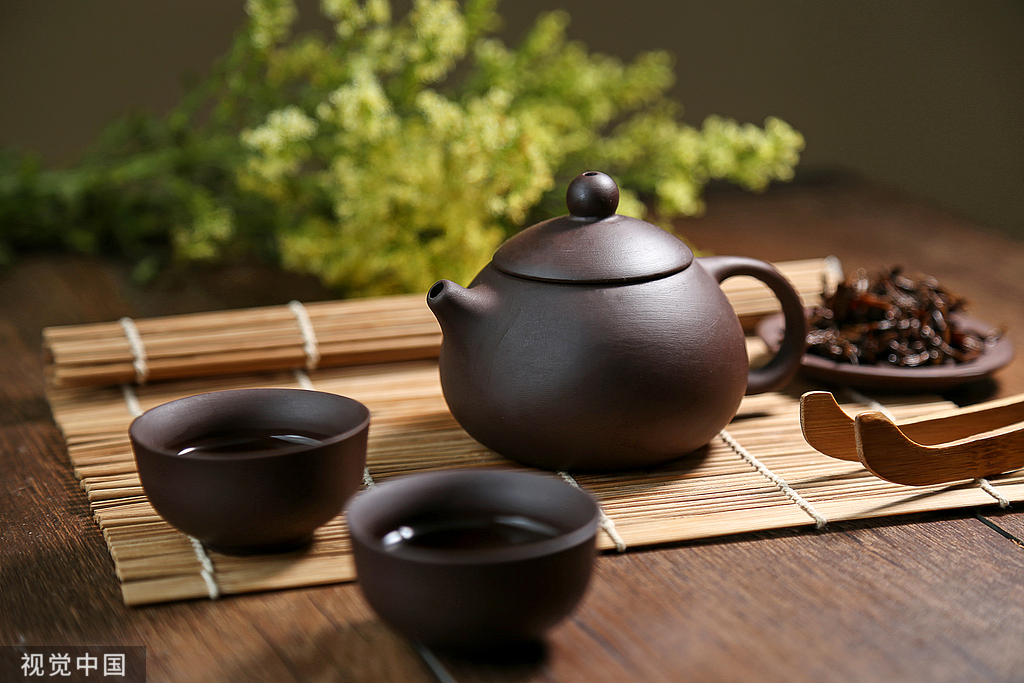
Zisha teapot and cups on a bamboo mat. Photo:VCG
China's traditional handcrafted zisha teapots are gaining popularity among overseas customers due to exceptional craftsmanship. Experts say the flourishing industry plays a growing role in promoting Chinese culture.
The zisha teapots produced in Yixing, Jiangsu Province, are expected to be exported to more than 50 countries and regions and accounted for 95 per cent of the global market this year.
"We primarily export to Southeast Asian markets, such as Singapore and Malaysia, where the tea culture is similar to that of China, making export negotiations easier," a representative surnamed Zhang from Taoyuanji Zisha Ceramic Company, a Yixing-based zisha teapot exporter told the Global Times on Friday.
"Yixing is the birthplace of zisha production, backed up by a comprehensive and complete supply chain. As a traditional Chinese cultural handicraft, zisha teapots must avoid industrialization and mechanization to preserve their cultural and artistic significance," Zhang said.
"Overseas clients choose our zisha teapots not only for their cultural value but also for the craftsmanship and high quality," a Yixing-based exporter, surnamed Zhou, told the Global Times on Friday. "One of the key reasons we export zisha teapots is to showcase China's traditional craftsmanship," Zhou said.
"The Southeast Asian market is one of the key markets for us, as the region has higher demand for tea sets and a better understanding of the cultural significance of zisha handicraft," Zhou added.
Yixing boasts a pottery-making history of over 7,300 years. In 2006, the craftsmanship of Yixing zisha pottery was recognized as part of the first batch of national intangible cultural heritage listings.
Exporters in Yixing told the Global Times that each handcrafted zisha teapot is unique, symbolizing both China's traditional tea culture and the heritage of its craftsmanship.
"Chinese handicrafts and traditional craftsmanship have gained significant popularity in overseas markets. This not only showcases the success of cultural exchange but also underscores the strong demand and interest from international consumers," Zhang Yi, CEO of iiMedia Research Institute, told the Global Times on Friday.
Zhang Yi noted that government backing is a key factor, with the authorities encouraging private companies to go global. And, local governments have also tried to help businesses expand internationally.
"This trend will strengthen in the future. As markets mature and China's cultural charm grows globally, Chinese handicrafts will see even greater international success, with strong market potential," Zhang Yi said.
An industry report from the industry site chinabaogao.com showed that Dingshu county in Yixing is the primary production base for zisha teapots in China, accounting for over 80 percent of the domestic market. Wuxi government revealed that Dingshu's online sales of zisha products reached 4.5 billion yuan ($634.2 million) in the first half of 2024.
The e-commerce sector for zisha products has seen explosive growth over the past three years. In 2023, an average of 1,500 merchants were live-streaming zisha sales on Douyin on a daily basis, and by February 2024, over 10,000 merchants were registered on platforms like Douyin and WeChat Channels, with 90 percent based in Dingshu county. The total number of zisha orders in 2024 exceeded 35 million pieces.


